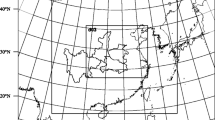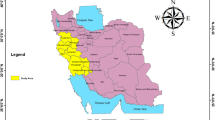Abstract
The characteristics and synoptic environment of an extreme rainfall event (maximum 24-h accumulated rainfall, 464 mm) in the warm sector over South China on 20 May 2016 are investigated. This warm sector torrential rain (WSTR) was occurring in the warm zone over the trumpet-shaped topography of Xinyi in the west of Guangdong Province. Large-scale analysis shows that the WSTR was continuously influenced by strong warm horizontal temperature advection from the Beibu Gulf and South China Sea accompanying with a cold front in the northwest. Water vapor fluxes in the lower troposphere reached 500 kg m−1 s−1 and total column water vapor exceeded 20 g kg−1 in the early stage of the WSTR. The topographic analysis showed that the WSTR was caused by the mesoscale convective boundary between the down-valley winds and the outbreak of the south winds from the south plain regions. The convections were strengthened and maintained due to the new generations of the convections by cold outflows and the south winds, as well as blocking effects caused by the trumpet-shaped topography over Xinyi. The strong convections were alleviated due to the weakening of south wind from the plain regions. Climatology statistical analysis confirms that the torrential rains are mainly concentrated during the night and early morning at 1200–2100 UTC and reach the peak at 1700–1800 UTC with a consistent high frequency of the surface wind convergence over Xinyi.



















Similar content being viewed by others
References
Atkins NT, Weisman ML, Wicker LJ (1999) The influence of preexisting boundaries on supercell evolution. Mon Weather Rev 127(12):2910–2927
Bao J, Michelson SA, Neiman PJ, Ralph FM, Wilczak JM (2006) Interpretation of enhanced integrated water vapor bands associated with extratropical cyclones: their formation and connection to tropical moisture. Mon Weather Rev 134:1063–1080
Boustead JM, Mayes BE, Gargan W, Leighton JL, Phillips G, Schumacher PN (2013) Discriminating environmental conditions for significant warm sector and boundary tornadoes in parts of the Great Plains. Weather Forecast 28:1498–1523
Carbone RE, Cooper WA, Lee W (1995) Forcing of flow reversal along the windward slopes of Hawaii. Mon Weather Rev 123:3466–3480
Corfidi S, Weiss S, Kain J, Corfidi S, Rabin R, Levit J (2010) Revisiting the 3–4 April 1974 Super Outbreak of tornadoes. Weather Forecast 25:465–510
Davis CA, Lee WC (2012) Mesoscale analysis of heavy rainfall episodes from SoWMEX/TiMREX. J Atmos Sci 69(2):521–537
Dee DP et al (2011) The ERA-Interim reanalysis: configuration and performance of the data assimilation systems. Quart J Roy Meteor Soc 137:553–597
Freychet N, Hsu H, Chou C, Wu C (2015) Asian summer monsoon in cmip5 projections: a link between the change in extreme precipitation and monsoon dynamics. J Clim 28:1477–1493
Fritsch JM, Kapolka J, Hirschberg PA (1992) The effects of subcloud-layer diabatic processes on cold air damming. J Atmos Sci 49:49–70
Fujita T, Bradbury DL, Van Thullenar CF (1970) Palm Sunday tornadoes of April 11, 1965. Mon Weather Rev 98:29–69
Galway JG (1977) Some climatological aspects of tornado outbreaks. Mon Weather Rev 105:477–484
Gimeno L, Stohl A, Trigo RM, Dominguez F, Yoshimura K, Yu L, Drumond A, Durán-Quesada AM, Nieto R (2012) Oceanic and terrestrial sources of continental precipitation, Rev Geophys 50, RG4003
Hamill TM, Schneider RS, Brooks HE, Forbes GS, Bluestein HB, Steinberg M, Melendez D, Dole RM (2005) The May 2003 extended tornado outbreak. Bull Am Meteorol Soc 86:531–542
Higgins RW, Yao Y, Yarosh ES, Janowiak JE, Mo KC (1997) Influence of the Great Plains low-level jet on summertime precipitation and moisture transport over the central United States. J Clim 10:481–507
Hoskins BJ, Bretherton FP (1972) Atmospheric frontogenesis models: mathematical formulation and solution. J Atmos Sci 29:11–37
Huang SS (1986) the pre-flood season rains in Southern China. Guangdong science and Technology Press, Guangzhou
Johns RH, Doswell CA (1992) Severe local storms forecasting. Weather Forecast 7:588–612
Lin LX (2006) Guangdong weather forecast technical manual. Meteorological Press. Beijing
Maddox RA, Chappell CF, Hoxit LR (1979) Synoptic and meso-β scale aspects of flash flood events. Bull Am Meteorol Soc 60:115–123
Maddox RA, Hoxit LR, Chappell CF (1980) A study of tornadic thunderstorm interactions with thermal boundaries. Mon Weather Rev 108(3):322–336
Newton CW (1967) Severe convective storms. Advances in Geophysics, 12, Academic Press, 257–303
Passarelli RE, Boehme H (1983) The orographic modulation of pre-warm-front precipitation in southern New England. Mon Weather Rev 111:1062–1070
Rasmussen EN, Straka JM, Davies-Jones R, Doswell CA III, Carr FH, Eilts MD, MacGorman DR (1994) Verification of the origins of rotation in tornadoes experiment: VORTEX. Bull Am Meteorol Soc 75(6):995–1006
Ruppert JH, Johnson RH, Rowe AK (2013) Diurnal Circulations and Rainfall in Taiwan during SoWMEX/TiMREX (2008). Mon Weather Rev 141:3851–3872
Sanders F (1999) A proposed method of surface map analysis. Mon Weather Rev 127:945–955
Schumacher RS, Johnson RH (2009) Quasi-stationary, extreme-rain-producing convective systems associated with midlevel cyclonic circulations. Weather Forecast 24(2):555–574
Tao SY (1980) The Chinese rainstorm. Chinese Science Press, Beijing
Tochimoto E, Niino H (2016) Structural and environmental characteristics of extratropical cyclones that cause tornado outbreaks in the warm sector: a composite study. Mon Weather Rev 144:945–969
Wu M, Luo Y (2016) Mesoscale observational analysis of lifting mechanism of a warm-sector convective system producing the maximal daily precipitation in China mainland during pre-summer rainy season of 2015. J Meteor Re 30(5):719–736
Wu P, Hara M, Hamada J, Yamanaka MD, Kimura F (2009) Why a large amount of rain falls over the sea in the vicinity of western sumatra island during nighttime. J Appl Meteor Climatol 48:1345–1361
Yu C, Lin C (2017) Formation and maintenance of a long-lived Taiwan rainband during 1–3 March 2003. J Atmos Sci 74:1211–1232
Acknowledgments
This study was supported by the National Natural Science Foundation of China (Grant Nos. 41505084, 41705035, 41505039), the China Meteorological Administration Special Public Welfare Research Fund (Grant Nos. GYHY201406003), and the Guangdong Province Public Welfare Research and Capacity Construction Project (Grant No. 2017B020218003).
Author information
Authors and Affiliations
Corresponding authors
Additional information
Responsible Editor: S. Trini Castelli.
Rights and permissions
About this article
Cite this article
Zhong, Sx., Li, Xy., Yang, S. et al. Characteristics and synoptic environment of torrential rain in the warm sector over South China: a composite study. Meteorol Atmos Phys 131, 1191–1203 (2019). https://doi.org/10.1007/s00703-018-0629-y
Received:
Accepted:
Published:
Issue Date:
DOI: https://doi.org/10.1007/s00703-018-0629-y




